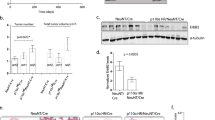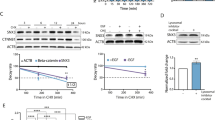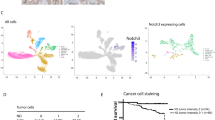Abstract
Transgenic mice overexpressing Notch4 intracellular domain (Int3) under the control of the whey acidic protein (WAP) or mouse mammary tumor virus-long terminal repeat promoters, develop mammary tumors. Microarray analysis of these tumors revealed high levels of c-Kit expression. Gleevec is a tyrosine kinase inhibitor that targets c-Kit, platelet-derived growth factor receptors (PDGFRs) and c-Abl. This led us to speculate that tyrosine kinase receptor activity might be a driving force in the development of Int3 mammary tumors. WAP-Int3 tumor-bearing mice were treated with continuous release of Gleevec using subcutaneously implanted Alzet pumps. Phoshorylation of c-Kit, PDGFRs and c-Abl is inhibited in Int3 transgenic mammary tumors by Gleevec. Inhibition of these enzymes is associated with a decrease in cell proliferation and angiogenesis, and an induction of apoptosis. To examine the signaling mechanisms underlying Notch4/Int3 tumorigenesis, we employed small interfering RNA (siRNA) to knock down c-Kit, PDGFRs and c-Abl alone or in combination and observed the effects on soft agar growth of HC11 cells overexpressing Int3. Only siRNA constructs for c-Kit and/or PDGFR-α were able to inhibit HC11-Int3 colony formation in soft agar. Our data demonstrate an inhibitory effect of Gleevec on Int3-induced transformation of HC11 cells and mammary tumors and indicate an oncogenic role for c-Kit and PDGFR-α tyrosine kinases in the context of Int3 signaling.
This is a preview of subscription content, access via your institution
Access options
Subscribe to this journal
Receive 50 print issues and online access
$259.00 per year
only $5.18 per issue
Buy this article
- Purchase on Springer Link
- Instant access to full article PDF
Prices may be subject to local taxes which are calculated during checkout







Similar content being viewed by others
References
Allenspach EJ, Maillard I, Aster JC, Pear WS . (2002). Notch signaling in cancer. Cancer Biol Ther 1: 466–476.
Ball RK, Friis RR, Schoenenberger CA, Doppler W, Groner B . (1988). Prolactin regulation of beta-casein gene expression and of a cytosolic 120-kDa protein in a cloned mouse mammary epithelial cell line. EMBO J 7: 2089–2095.
Basciani S, Brama M, Mariani S, De Luca G, Arizzi M, Vesci L et al. (2005). Imatinib mesylate inhibits Leydig cell tumor growth: evidence for in vitro and in vivo activity. Cancer Res 65: 1897–1903.
Besmer P, Murphy JE, George PC, Qiu FH, Bergold PJ, Lederman L et al. (1986). A new acute transforming feline retrovirus and relationship of its oncogene v-kit with the protein kinase gene family. Nature 320: 415–421.
Betsholtz C . (2003). Biology of platelet-derived growth factors in development. Birth Defects Res C Embryo Today 69: 272–285.
Callahan R, Raafat A . (2001). Notch signaling in mammary gland tumorigenesis. J Mammary Gland Biol Neoplasia 6: 23–36.
Carvalho I, Milanezi F, Martins A, Reis RM, Schmitt F . (2005). Overexpression of platelet-derived growth factor receptor alpha in breast cancer is associated with tumour progression. Breast Cancer Res 7: R788–R795.
Chiaramonte R, Basile A, Tassi E, Calzavara E, Cecchinato V, Rossi V et al. (2005). A wide role for NOTCH1 signaling in acute leukemia. Cancer Lett 219: 113–120.
Cortes J, O'Brien S, Kantarjian H . (2004). Discontinuation of imatinib therapy after achieving a molecular response. Blood 104: 2204–2205.
Dang TP, Eichenberger S, Gonzalez A, Olson S, Carbone DP . (2003). Constitutive activation of Notch3 inhibits terminal epithelial differentiation in lungs of transgenic mice. Oncogene 22: 1988–1997.
Dang TP, Gazdar AF, Virmani AK, Sepetavec T, Hande KR, Minna JD et al. (2000). Chromosome 19 translocation, overexpression of Notch3, and human lung cancer. J Natl Cancer Inst 92: 1355–1357.
Das AV, James J, Zhao X, Rahnenfuhrer J, Ahmad I . (2004). Identification of c-Kit receptor as a regulator of adult neural stem cells in the mammalian eye: interactions with Notch signaling. Dev Biol 273: 87–105.
de Jong JS, van Diest PJ, van der Valk P, Baak JP . (1998). Expression of growth factors, growth inhibiting factors, and their receptors in invasive breast cancer. I: an inventory in search of autocrine and paracrine loops. J Pathol 184: 44–52.
Diallo R, Rody A, Jackisch C, Ting E, Schaefer KL, Kissler S et al. (2006). C-KIT expression in ductal carcinoma in situ of the breast: co-expression with HER-2/neu. Hum Pathol 37: 205–211.
Dievart A, Beaulieu N, Jolicoeur P . (1999). Involvement of Notch1 in the development of mouse mammary tumors. Oncogene 18: 5973–5981.
Dontu G, Jackson KW, McNicholas E, Kawamura MJ, Abdallah WM, Wicha MS . (2004). Role of Notch signaling in cell-fate determination of human mammary stem/progenitor cells. Breast Cancer Res 6: R605–R615.
Gallahan D, Callahan R . (1997). The mouse mammary tumor associated gene INT3 is a unique member of the NOTCH gene family (NOTCH4). Oncogene 14: 1883–1890.
Gallahan D, Jhappan C, Robinson G, Hennighausen L, Sharp R, Kordon E et al. (1996). Expression of a truncated Int3 gene in developing secretory mammary epithelium specifically retards lobular differentiation resulting in tumorigenesis. Cancer Res 56: 1775–1785.
Gallahan D, Kozak C, Callahan R . (1987). A new common integration region (int-3) for mouse mammary tumor virus on mouse chromosome 17. J Virol 61: 218–220.
Ghatak S, Misra S, Toole BP . (2002). Hyaluronan oligosaccharides inhibit anchorage-independent growth of tumor cells by suppressing the phosphoinositide 3-kinase/Akt cell survival pathway. J Biol Chem 277: 38013–38020.
Heinrich MC, Corless CL, Duensing A, McGreevey L, Chen CJ, Joseph N et al. (2003). PDGFRA activating mutations in gastrointestinal stromal tumors. Science 299: 708–710.
Hwang RF, Yokoi K, Bucana CD, Tsan R, Killion JJ, Evans DB et al. (2003). Inhibition of platelet-derived growth factor receptor phosphorylation by STI571 (Gleevec) reduces growth and metastasis of human pancreatic carcinoma in an orthotopic nude mouse model. Clin Cancer Res 9: 6534–6544.
Imatani A, Callahan R . (2000). Identification of a novel NOTCH-4/INT-3 RNA species encoding an activated gene product in certain human tumor cell lines. Oncogene 19: 223–231.
Jeffries S, Capobianco AJ . (2000). Neoplastic transformation by Notch requires nuclear localization. Mol Cell Biol 20: 3928–3941.
Jhappan C, Gallahan D, Stahle C, Chu E, Smith GH, Merlino G et al. (1992). Expression of an activated Notch-related int-3 transgene interferes with cell differentiation and induces neoplastic transformation in mammary and salivary glands. Genes Dev 6: 345–355.
Kim MK, Higgins J, Cho EY, Ko YH, Oh YL . (2000). Expression of CD34, bcl-2, and kit in inflammatory fibroid polyps of the gastrointestinal tract. Appl Immunohistochem Mol Morphol 8: 147–153.
Lasota J, Jasinski M, Sarlomo-Rikala M, Miettinen M . (1999). Mutations in exon 11 of c-Kit occur preferentially in malignant versus benign gastrointestinal stromal tumors and do not occur in leiomyomas or leiomyosarcomas. Am J Pathol 154: 53–60.
le Coutre P, Mologni L, Cleris L, Marchesi E, Buchdunger E, Giardini R et al. (1999). In vivo eradication of human BCR/ABL-positive leukemia cells with an ABL kinase inhibitor. J Natl Cancer Inst 91: 163–168.
Leveen P, Pekny M, Gebre-Medhin S, Swolin B, Larsson E, Betsholtz C . (1994). Mice deficient for PDGF B show renal, cardiovascular, and hematological abnormalities. Genes Dev 8: 1875–1887.
Marley SB, Gordon MY . (2005). Chronic myeloid leukaemia: stem cell derived but progenitor cell driven. Clin Sci (London) 109: 13–25.
Matsui J, Wakabayashi T, Asada M, Yoshimatsu K, Okada M . (2004). Stem cell factor/c-kit signaling promotes the survival, migration, and capillary tube formation of human umbilical vein endothelial cells. J Biol Chem 279: 18600–18607.
Noseda M, McLean G, Niessen K, Chang L, Pollet I, Montpetit R et al. (2004). Notch activation results in phenotypic and functional changes consistent with endothelial-to-mesenchymal transformation. Circ Res 94: 910–917.
Pear WS, Aster JC . (2004). T cell acute lymphoblastic leukemia/lymphoma: a human cancer commonly associated with aberrant NOTCH1 signaling. Curr Opin Hematol 11: 426–433.
Raafat A, Bargo S, Anver MR, Callahan R . (2004). Mammary development and tumorigenesis in mice expressing a truncated human Notch4/Int3 intracellular domain (h-Int3sh). Oncogene 23: 9401–9407.
Ramalho-Santos M, Yoon S, Matsuzaki Y, Mulligan RC, Melton DA . (2002). ‘Stemness’: transcriptional profiling of embryonic and adult stem cells. Science 298: 597–600.
Reedijk M, Odorcic S, Chang L, Zhang H, Miller N, McCready DR et al. (2005). High-level coexpression of JAG1 and NOTCH1 is observed in human breast cancer and is associated with poor overall survival. Cancer Res 65: 8530–8537.
Robbins J, Blondel BJ, Gallahan D, Callahan R . (1992). Mouse mammary tumor gene int-3: a member of the notch gene family transforms mammary epithelial cells. J Virol 66: 2594–2599.
Smith GH, Gallahan D, Diella F, Jhappan C, Merlino G, Callahan R . (1995). Constitutive expression of a truncated INT3 gene in mouse mammary epithelium impairs differentiation and functional development. Cell Growth Differ 6: 563–577.
Soriano P . (1994). Abnormal kidney development and hematological disorders in PDGF beta-receptor mutant mice. Genes Dev 8: 1888–1896.
Taniguchi M, Nishida T, Hirota S, Isozaki K, Ito T, Nomura T et al. (1999). Effect of c-kit mutation on prognosis of gastrointestinal stromal tumors. Cancer Res 59: 4297–4300.
Tsuda H, Morita D, Kimura M, Shinto E, Ohtsuka Y, Matsubara O et al. (2005a). Correlation of KIT and EGFR overexpression with invasive ductal breast carcinoma of the solid-tubular subtype, nuclear grade 3, and mesenchymal or myoepithelial differentiation. Cancer Sci 96: 48–53.
Tsuda H, Tani Y, Weisenberger J, Kitada S, Hasegawa T, Murata T et al. (2005b). Frequent KIT and epidermal growth factor receptor overexpressions in undifferentiated-type breast carcinomas with ‘stem-cell-like’ features. Cancer Sci 96: 333–339.
Uehara H, Kim SJ, Karashima T, Shepherd DL, Fan D, Tsan R et al. (2003). Effects of blocking platelet-derived growth factor-receptor signaling in a mouse model of experimental prostate cancer bone metastases. J Natl Cancer Inst 95: 458–470.
Ulivi P, Zoli W, Medri L, Amadori D, Saragoni L, Barbanti F et al. (2004). c-kit and SCF expression in normal and tumor breast tissue. Breast Cancer Res Treat 83: 33–42.
Wang D, Huang HJ, Kazlauskas A, Cavenee WK . (1999). Induction of vascular endothelial growth factor expression in endothelial cells by platelet-derived growth factor through the activation of phosphatidylinositol 3-kinase. Cancer Res 59: 1464–1472.
Weijzen S, Rizzo P, Braid M, Vaishnav R, Jonkheer SM, Zlobin A et al. (2002). Activation of Notch-1 signaling maintains the neoplastic phenotype in human Ras-transformed cells. Nat Med 8: 979–986.
Acknowledgements
We thank Dr Barbara Vonderhaar and Dr Gilbert H Smith for their critical review of the manuscript. We specially thank Novartis Pharmaceuticals for providing Gleevec.
Author information
Authors and Affiliations
Corresponding author
Rights and permissions
About this article
Cite this article
Raafat, A., Zoltan-Jones, A., Strizzi, L. et al. Kit and PDGFR-α activities are necessary for Notch4/Int3-induced tumorigenesis. Oncogene 26, 662–672 (2007). https://doi.org/10.1038/sj.onc.1209823
Received:
Revised:
Accepted:
Published:
Issue Date:
DOI: https://doi.org/10.1038/sj.onc.1209823
Keywords
This article is cited by
-
The ANK repeats of Notch-4/Int3 activate NF-κB canonical pathway in the absence of Rbpj and causes mammary tumorigenesis
Scientific Reports (2017)
-
Analysis of Brca1-deficient mouse mammary glands reveals reciprocal regulation of Brca1 and c-kit
Oncogene (2011)
-
Rbpj conditional knockout reveals distinct functions of Notch4/Int3 in mammary gland development and tumorigenesis
Oncogene (2009)



